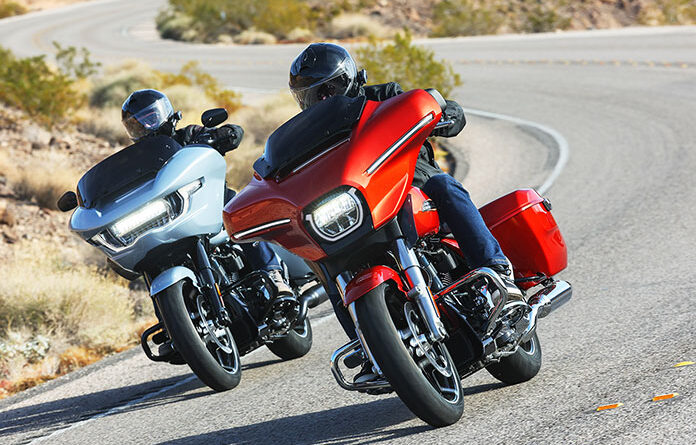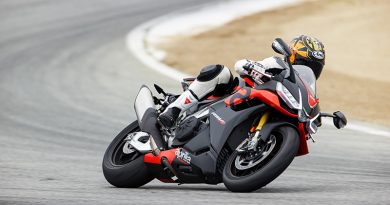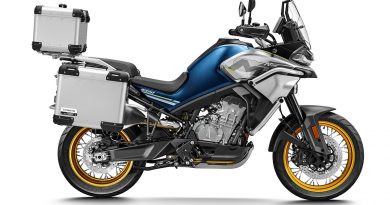2024 Harley-Davidson Glide Models Review | First Ride
If you have only a minute, here’s what you need to know about the 2024 Harley‑Davidson Glide models: The new OE Road/Street Glides are basically last year’s CVOs but with 117ci engines instead of the VVT 121. There, now you can go back to fettling your Shovelhead.
2023 Harley-Davidson CVO Street Glide and Road Glide Review | First Ride
But, of course, there’s much more to the story about extensive revisions to America’s bestselling streetbikes. Take a ride with us from Lake Las Vegas into the surrounding remote areas.
Harley-Davidson Glide CVO to OE
This is the first major update to Harley’s Grand American Touring motorcycle portfolio since the Project Rushmore bikes debuted in 2013. Almost all the attributes we enjoyed about the thoroughly updated CVO Road Glide and Street Glide that debuted last summer are seen here in OE form: the same fairings, fuel tanks, and instrument panels.
The biggest deviation from CVO to OE is found in their Milwaukee‑Eight powerplants. The 117ci engines seen here use the CVO’s liquid‑cooled cylinder heads but don’t have the variable valve timing of the 121 VVT. Other changes include a 50% larger air cleaner than the Heavy Breathers on the 107s and 114s, and the throttle body steps up from 55mm to 58mm (2.3 inches). Horsepower is bumped 3% to 105 hp at 4,600 rpm, while torque is lifted 4% to 130 lb‑ft at 3,250 rpm.
Bodywork Work
Many graybeards turned up their noses when they first saw the fresh styling of the CVO Glides – it’s human nature to reject change. Seven months later, it seems as if the MoCo faithful are softening their harsh opinions, particularly for the elegant yet familiar Street Glide.
2024 Harley-Davidson Icons and Enthusiast Collections Review | First Look
These new OE Harley-Davidson Glide models are basically identical to their CVO brethren, including the fuel tanks with chamfered upper edges that are 2 lb lighter than before but still hold 6 gallons. Further weight is trimmed by using a triple‑clamp fabricated by a liquid‑aluminum forging process, shaving off about 7 lb from this critical area. The new RG is purportedly 16 lb lighter than the previous RG Special; the SG has lost 18 lb relative to the old SG Special.
GEAR UP
Helmet: SMK Retro Seven
Jacket: Alpinestars Hoxton V2
Pants: Alpinestars GPX V2
Boots: Highway 21 Journeyman
TFT‑ease
The upgrade riders will have their eyes on most is the stunning TFT instrument panel. At 12.3 inches, it’s diagonally 90% larger than the previous screen. It includes three display options: Cruise, which is a traditional layout; Sport, with a central tach/speedo, leaving more space on the sides for customizable widget displays; and Tour, with most of the screen occupied by maps and directions.
It’s all managed by H‑D’s Skyline OS, and preferences can be set via the glove‑friendly touchscreen or the various handlebar buttons. Audio wattage has been doubled to 200 watts, sending tunes to two 5.25‑inch speakers in the fairings.
Ride modes are part of the package. Owners tap into different combinations of power delivery, engine braking, cornering ABS, and traction‑control parameters by selecting from Road, Sport, Rain, or Custom. H‑D’s Rider Safety Enhancements electronics suite is standard equipment, monitoring the linked brakes, cornering ABS, Drag Torque Slip Control, and Vehicle Hold Control.
Rather than the CVO’s inverted fork and radial‑mount Brembo calipers, the OE Glides make do with a retuned 49mm nonadjustable fork with 4.6 inches of travel, as well as the previous 4‑piston axial‑mount calipers.
The rear suspension receives a welcome upgrade, with travel up 43% from a scant 2.1 inches to a more reasonable 3 inches. Dual Showa shocks replace the old bikes’ dampers, now using emulsion technology in both instead of just one, which is claimed to improve responsiveness.
Harley-Davidson Glide Guide
For the few of you who are unaware, the Street Glide and the Road Glide are essentially the same motorcycle but with different fairings. The SG uses a version of the iconic batwing fairing that was originally introduced in 1969. Ten years later saw the arrival of Harley’s sharknose fairing on the FLT Tour Glide, which was followed in 1998 by the first official Road Glide.
Like everything in life, there is a compromise to be made in choosing the Harley-Davidson Glide that works best for you. The RG’s frame‑mounted fairing offers more wind protection, while the SG’s handlebar‑mounted batwing is more svelte but contributes to slightly heavier steering and can be affected by gusty crosswinds.
From behind the bars, the SG feels like a much smaller motorcycle than the RG with its gargantuan fairing. This makes the 838‑lb SG feel more adept during low‑speed maneuvering even though they have similar weights.
Glides Rides
I first hopped aboard a Road Glide in its Sharkskin Blue colorway, a “premium” color that carries an $850 upcharge over the standard Billiard Gray base version. The new instrument panel enhances the bike’s high‑end impression and clearly delivers info to a rider, including tire pressures. The upgraded switchgear also impresses with a higher‑quality tactileness. The RG’s cockpit includes a pair of storage compartments, and the bin on the right side is equipped with a USB‑C connector.
The new 117ci motor spits out stately levels of grunt at all points of its powerband. It’s only in comparison with the CVOs’ 121ci M‑8s that it comes up a bit short. Almost everyone will think it’s more than adequate. I dialed in the Road ride mode for the smooth throttle response I desired for this mostly casual ride.
While I enjoyed the full roar emitted from the exhaust system, the output from the audio system gets overwhelmed by wind noise above 65 mph. Although rated at 200 watts, it puts out 50 watts per channel, with only two speakers – the extra 100 watts will only be heard after fitting a pair of saddlebag speakers.
When I swapped over to a Street Glide, I enjoyed a more suitable riding position for my smaller physique. The SG’s lower handlebar feels more natural for my stature, while the RG’s bar places the grips just a few inches lower than my shoulders. The touchscreen display on the SG is also much closer to the rider than the RG’s, making it much more accessible.
Both Glides have adjustable vanes on the sides of their fairings to redirect airflow, plus a vent at the center of the windscreens that can be adjusted to smooth the air that hits a rider’s helmet. Another much‑appreciated feature on the SG is its slide‑out storage tray directly below the instrument panel, which is super convenient for stashing any small items.
The smooth Nevada roads we traveled didn’t challenge the suspension, but the few bumps we hit made me grateful for the additional travel provided by the new shocks. They provide a major upgrade in ride quality compared to the previous shorty shocks. The brakes are plenty capable but not to the high levels of power offered by the hardware on the CVOs.
The Verdict
New OE Harley-Davidson Glide gripes are few. The heavy clutch requires a strong pull, and the 6‑speed transmission swaps cogs with a clunkiness unbecoming of a modern gearbox. But the upgraded motor is very satisfying, and the additional rear suspension travel is a major improvement that allows the Glides to glide over bumps that previously would shock a rider’s spine.
The only real impediment to pulling the trigger on a new Glide is their pricey MSRPs, starting at $25,999. Both bikes have chrome finishes as standard, while black finishes cost an extra $1,350. Color options beyond Billiard Gray add another $850.
While that’s a significant chunk of change, it’s far less than the CVOs, which are priced above $40K. If you gotta roll in style on a Harley bagger, these new Glides are a substantial improvement over the older ones. Even the graybeards will have to agree.
Check out more new bikes in Rider’s 2024 Motorcycle Buyers Guide
The post 2024 Harley-Davidson Glide Models Review | First Ride appeared first on Rider Magazine.




